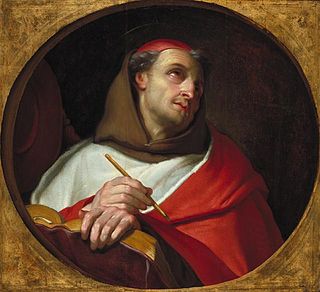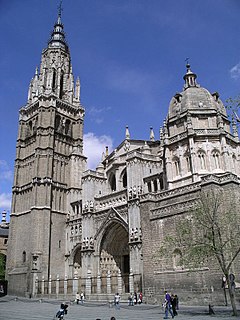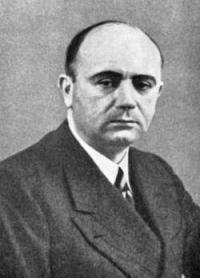
The Divine Comedy is an Italian narrative poem by Dante Alighieri, begun c. 1308 and completed in 1320, a year before his death in 1321. It is widely considered the pre-eminent work in Italian literature and one of the greatest works of world literature. The poem's imaginative vision of the afterlife is representative of the medieval worldview as it existed in the Western Church by the 14th century. It helped establish the Tuscan language, in which it is written, as the standardized Italian language. It is divided into three parts: Inferno, Purgatorio, and Paradiso.

Year 1284 (MCCLXXXIV) was a leap year starting on Saturday of the Julian calendar.

Alfonso X was King of Castile, León and Galicia from 30 May 1252 until his death in 1284. During the election of 1257, a dissident faction chose him to be king of Germany on 1 April. He renounced his claim to Germany in 1275, and in creating an alliance with the Kingdom of England in 1254, his claim on the Duchy of Gascony as well.

Bonaventure, born Giovanni di Fidanza, was an Italian Catholic Franciscan, bishop, cardinal, scholastic theologian and philosopher.

Ferdinand de la Cerda was the heir apparent to the Crown of Castile as the eldest son of Alfonso X and Violant of Aragon. His nickname, de la Cerda, means "of the bristle" in Spanish, a reference to being born with a full head of hair.

The Alfonsine Tables, sometimes spelled Alphonsine Tables, provided data for computing the position of the Sun, Moon and planets relative to the fixed stars.
Bonaventure, a French name may refer to:

The Toledo School of Translators is the group of scholars who worked together in the city of Toledo during the 12th and 13th centuries, to translate many of the Judeo-Islamic philosophies and scientific works from Classical Arabic into Latin.
A number of Latin biographies of Muhammad were written during the 9th to 13th centuries.
The Kitab al Miraj is a Muslim book concerned with Muhammad's ascension into Heaven, following his miraculous one-night journey from Mecca to Jerusalem. The book is divided into 7 chapters, and was written in Arabic using the Naskh script.

María Alfonso Téllez de Meneses, known as María de Molina, was queen consort of Castile and León from 1284 to 1295 by marriage to Sancho IV of Castile, and served as regent for her minor son Ferdinand IV and later her grandson Alfonso XI of Castile (1312-1321).

Violant or Violante of Aragon, also known as Yolanda of Aragon, was Queen consort of Castile and León from 1252 to 1284 as the wife of King Alfonso X of Castile.

Alfonso X of Castile, also known as Alfonso the Wise, ruled from 1252 until 1284. One of Alfonso’s goals for his kingdom was to lift Castile out of the Dark Ages by producing a united, educated, artistic, and religious population. His desire to bring Castile into the mainstream of high civilization led to a boom of cultural activity, including the production and translation of a great deal of literature. The literature produced during his reign was intended to aid him in achieving his goal by giving the common people of Spain access to great intellectual works. Therefore, all of the prose attributed to Alfonso X’s efforts was written in the language of the common people, Castilian, rather than Latin, which was the language of prestige at that time. Although the works are generally attributed to Alfonso X, being a king with other business to deal with he did not himself write most of them. Instead, Alfonso’s role was that of choosing works to be produced and translated, funding the projects, selecting the true authors of the work, overseeing the production, and occasionally contributing personally.

Enrico Cerulli was an Italian scholar of Somali and Ethiopian studies, a governor and a diplomat.
Abu Yusuf Yaqub ibn Abd al-Haqq was a Marinid ruler of Morocco. He was the fourth son of Marinid founder Abd al-Haqq, and succeeded his brother Abu Yahya in 1258. He died in 1286.
The Collationes in Hexaemeron are an unfinished series of theological lectures given by St. Bonaventure in Paris between Easter and Pentecost 1273.

Alfonso de la Cerda,, called "the disinherited," was the elder son of Ferdinand de la Cerda and his wife Blanche of France, and was a grandson of Alfonso X of Castile. Alfonso and his brother Fernando were candidates for the Castilian-Leonese crown during the reigns of Sancho IV of Castile, Ferdinand IV of Castile and Alfonso XI of Castile. In 1331, Alfonso renounced his rights and swore allegiance to Alfonso XI of Castile.

The Romance of Muhammad is an Old French romance about the life of Muhammad in octosyllabic couplets. It was written by Alexandre du Pont in 1258 in Laon based on the earlier Otia de Machomete, a Latin poem by Walter of Compiègne. At 1,996 verses, it is almost twice as long as the Otia. It is preserved in a single manuscript in Paris, Bibliothèque nationale de France, fonds français 1553, from the late 13th century.
Abraham of Toledo, also known as Abraham Alfaquín and Abraham Ibn Waqar, was an Iberian Jewish physician and translator of the Toledo School of Translators. He served as personal physician to Alfonso X of Castile and his son Sancho IV of Castile, under whose patronage he translated numerous books from Arabic into Castilian. Together with five other prominent court Jews, he was kidnapped and held hostage from 1270 to 1275 by rebellious nobles demanding the elimination of taxes.

The Book of Muḥammad's Ladder is a first-person account of the Islamic prophet Muḥammad's night journey (isrāʾ) and ascent to heaven (miʿrāj), translated into Latin and Old French from traditional Arabic materials. Although presented as Muḥammad's words and purportedly recorded by Muḥammad's cousin Ibn ʿAbbās, the work dates to the 13th century.














